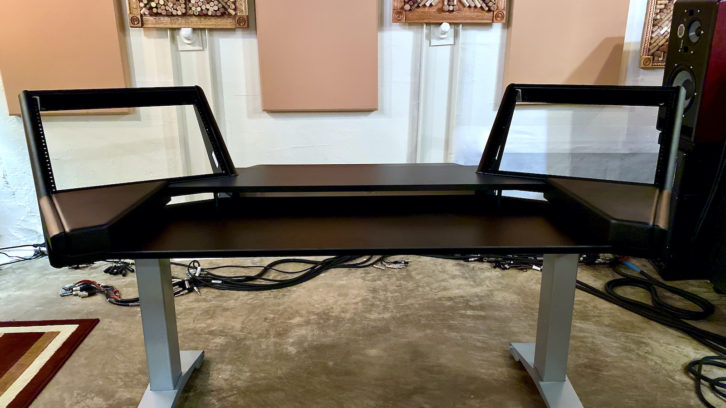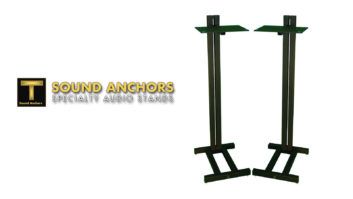Any pursuit of improved control room acoustics must go beyond surface treatments, monitors and DSP. The workstations/furniture that house the gear and put the “control” in control room absolutely make a difference. In my never-ending pursuit of a sweeter sweet-spot, I’ve turned to replacing my 20-year old rack furniture that once held an analog console and plenty of outboard processing, but now contains simply analog summing and minimal processors. Hoping to reduce the sonic imprint of the furniture, smooth out the frequency response, increase the ergonomics and modernize the look, I recently purchased an Argosy HaloK workstation, low-profile rolling rack and speaker stands from Argosy Console.
ARGOSY HALOK DESK
This particular workstation series incorporates a wraparound “cockpit” desktop design with an 8-space rack angled upward and inward on both sides, a small shelf between the racks and a small center shelf sunken down to the rear.
The Argosy HaloK model ($1,979) I chose has a large portion of the main desk area sunken down a few inches as an ideal place for a 61-key synthesizer/keyboard (88-key models are also available). The lowered shelf could alternately accommodate a touchscreen DAW controller or a QWERTY keyboard with mouse, or maybe a number of control pads, or maybe a metronome, headphone amp and lots of coffee…like mine does.
The Argosy HaloK is supported by a pair of large steel legs that make for an open under-desk area. Those legs bolt directly to a pair of heavy steel support trays that together form the unit’s skeleton and provide the base of each 8-space rack. The rack wings and various shelves are made of an MDF wood material that has been precision-routed for all connection points. Those connections consist of dowels, screws and slot-head nuts; all can be inserted and tightened with no more than a Phillips-head screwdriver and a provided Allen wrench.
At first glance, it looks like minimal materials make up not a terribly large desk. Once you start putting everything together, it appears quite substantial.
Austrian Audio CC8 Microphone — A Real-World Review
Sterling SHA4 Headphone Amplifier – A Real-World Review
Lauten Audio LS-308 – A Real-World Review
My desk consisted of four large cardboard packages, none all that tall (about 4 feet), or wide, or heavy; no more than six inches deep, so I was able to handle each numbered package alone. Assembly requires a large, open and (ideally) carpeted space for room to spread out all the parts and not damage the finishes. Between myself and an assistant, we assembled the desk in about 90 minutes, following (mostly) clear instructions in the manual and with only moderate difficulty. All the routings were precise enough that all the connection points held firm and the final product was “squaredup”— not wobbly, quite stable and rather heavy once loaded with gear (the HaloK is rated for up to 200 pounds of additional weight).
I was concerned that the sides of the rack gear might be unattractive without the concealing wings and panels of Argosy’s Dual15 Series. The cable tray that runs along the back of the Argosy HaloK is aluminum and plenty large, so it neatly holds the thick 32-pair snakes I employ. Also, the two legs are hollow, allowing some cable runs to be tucked away there, too. Nonetheless, once fully connected, it was a messy eyesore, so I ended up using a black drape neatly clipped to the backside of the Argosy HaloK; it disguises most of the wiring and only absorbs high frequencies.
Additional options include small rack-top monitor shelves, (angle accommodated) rack shelves and articulating video monitor arms.

RACK ‘N ROLL
In order to get more rackspace to hold a front-end of mic preamps (enough to capture large bands), I also ordered an Argosy 10-space Rack ’n Roll roll-around rack bucket ($519). Built in the same manner as the HaloK, the rack assembled easily and finished snugly. It now feels sturdy and looks great.
The light-duty wheels seem adequate so far (with an eye on potential upgrading), and having my mic inputs at this angle is the best thing ever! I should have done my lower-back and my eyes this favor a long time ago. Controls are far easier to see and grab than in vertical racks. Plus, you can wheel the whole thing out of the way as needed. To have 24 channels of mic amps right smack where I need them (and not causing any acoustic disturbance) has made a world of difference, especially during harried tracking sessions.
SPIRE SPEAKER STANDS
I had to address the need for speaker stands to hold a very large pair of Focal Trio11Be monitors—in just the right spots to “see” over the HaloK’s racks and not create unwanted reflections.
I ordered a pair of Spire 360 Xi stands ($579) that incorporate the same MDF material used in the HaloK. The Rack ’n Roll rack comes in a non-adjustable 36-inch height (except for an inch, via optional small risers that also allow a small tilt if desired), and IsoAcoustics isolators are built right-in to minimize energy transfer from the monitors to the stands.
Assembly was easy, with a snug fit, but I’m not completely sold on the sturdiness of the design. Once loaded with the large 80-pound monitors, there is a small amount of sway possible that I would like to eliminate. With normal-sized (i.e., lower-weight) monitors, most users will find these stands beyond adequate and sturdier than budget models.
It turns out that 36-inch stands are a little too short for the HaloK, so I placed the Spires on large cement blocks. I would recommend the Spire 420Xi’s with their 42-inch height to perfectly perch over the HaloK’s racks.
EVALUATION AND MIXING
Once everything was completely set up, I did some room response measurements using Dirac Live and Sonarworks. Each program responds differently, but generally speaking, I measured no difference in bottom-end response with the Argosy setup; (predictably) the same dip and the same boost remained.
High-end response above 500 Hz showed many small variations, but remained pleasantly nearly flat. Midrange response showed the same troublesome 300 – 400 Hz bump (ceiling induced) as before, but the 120 – 250 range flattened out considerably with the HaloK (presumably due to the lack of low-mid build-up).
Listening and mixing revealed a number of small sonic improvements with the Argosy setup. A cloudy 200 Hz area seemed much clearer, bottom-end punch improved, imaging seemed more pinpointed/exacting, and the sense of front-to-back space opened up a bit. I can’t say that things sound all that different to my clients behind me on the couch, but in the sweet spot, I have definitely made improvements in neutrality and clarity that are translating to confident mix moves and better results.
It deserves mention that I moved my two video monitors off of the HaloK completely, with both perched on thin metal stands very close to the wall and strategically just below. This placement allows less sonic diffraction/reflection, helps clean up the low-mid frequencies, and my bi-focals maintain a good view of both monitors even as I remain efficiently stationary in the ideal spot.
I should also mention that the HaloK’s prominent legs are gray, are not available in other finishes and are not easily customized to another color without considerable sanding and then powder-coating. I simply had to have color coordination, so I hand-painted them, with the mediocre results that are to be expected from skimping out on a proper paint job.
SUMMARY
The Argosy HaloK, Rack ’n Roll and Spires are not cheap, but they are not disposable, Ikea-type furniture, either. The design is on-point, the height is right, the angles are perfect and the desk is built for efficiency in audio.
Other models from Argosy (the Dual 15, Eclipse or Universal series) may work better for video editors needing wider designs (with room for multiple video monitors), or the standard Halo model for taller engineers (where the desktop surface sits a few crucial inches higher), or even motorized sit-stand Halo models for considerably more cost.
Supply chain issues delayed the arrival of my HaloK, and I needed a replacement part, but the Argosy team was attentive, sharp and communicative from day one, providing far better service than has become the norm as of late. With such exemplary service, smart designs, good materials, ergonomics and sonic improvements, I can definitely recommend the Argosy Console control room products. I would also recommend you “measure twice, buy once;” buy 42-inch speaker stands and don’t overload your stands with excessive weight and size.
COMPANY: Argosy Console
PRODUCTS: HaloK, Rack ’n Roll, Spire 360Xi
WEBSITE: www.argosyconsole.com
PRICE: $1979 (HaloK), $519 (Rack ‘n Roll), $579 (Spire 360Xi)
PROS: Easy assembly, solid build, ergonomic features, attractive look
CONS: Limited color options, more cable management needed, minimal height adjustment







